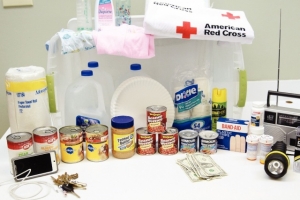It's time to get ready for hurricane season
By Becky Barclay
Published in News on July 24, 2014 1:46 PM

As Wayne County goes through hurricane season, Red Cross members advise people to create a preparedness kit like this one.
Being prepared before a hurricane hits will make life after the storm a little bit easier and might even save your life.
That's why the Wayne County chapter of the American Red Cross is encouraging local residents to make a disaster supply kit. Hurricane season runs through the end of September.
What should you put in your disaster kit?
Everyone's will be different, depending on their likes and needs, said Tammy Forrester, chief executive officer for the Wayne, Lenoir and Greene County chapter of the Red Cross.
But there are some basic things that should be included in every kit.
"You have things like water, one gallon per day per person," Mrs. Forrester said. "And don't forget to include a blanket. You never know when you're going to need it. It doesn't have to be cold outside to need a blanket."
Food will be a very important part of your disaster kit, Mrs. Forrester said. Make sure it's food you can eat without having to warm it up.
"Beanie Weenies is my son's personal favorite," she said. "You can also include Vienna sausages. And peanut butter is a good source of protein."
Families that have an infant should also include things like diapers, bottles and formula powder.
If you have pets, don't forget about them. Include their food in your disaster kit.
"Another important thing to have in your disaster kit is a battery-operated radio," Mrs. Forrester said. "If the power goes out, you won't be able to be informed about it if you don't have something like that.
"Include a flashlight. And don't forget extra batteries. Most people say, 'I have a flashlight and I know where it is.' But when is the last time the batteries were changed?"
Make sure you also put your prescription medications in your kit.
"It's important that you have not just over-the-counter pain reliever for sprains or headaches, but also prescriptions if you have certain health conditions," Mrs. Forrester said.
Also, put your cell phone and chargers in the disaster kit when you know a storm is approaching. You should even put a set of keys in the kit with keys for your home, sheds, firebox, file cabinets and even work.
Mrs. Forrester said a lot of people don't think about including cash in their kit.
"This is a biggie," she said. "If the power goes out, you won't be able to get any cash from the ATM."
Stick some bug repellent in there, too.
"Always, it seems like after a hurricane, the humidity is terrible and it brings out bugs, bugs, bugs," Mrs. Forrester said.
You should put all these things into a plastic waterproof container.
"It's having everything you need in one spot," Mrs. Forrester said. "Having a disaster kit, if you have to leave in a hurry, you can grab one thing with everything in it and go. If you have to gather it all up, you're going to forget something. You can make a disaster kit in June at the beginning of the month and you can keep it all the way through September. This stuff will last through September. Then you'll be prepared.
"After hurricane season is over, you can use the items and replenish them next hurricane season."
Mrs. Forrester said that having a disaster kit buys you some time to make a plan after a hurricane strikes.
"It buys you the opportunity after the disaster to sit down, take a breath and find out what's going on next, where you can go and how you can get help. Usually by then, the Red Cross is there to help. It's a peace of mind."
In addition to making a disaster kit, there are other things you can do when you know a hurricane in imminent.
"Gas up your cars," Mrs. Forrester said. "And then you've got gas if you have to evacuate."
You should also clean your bathtub and fill it with water you can use after the storm to bathe in or to flush your toilet.
"And if you haven't lost power, but the water in your community is contaminated from the storm, you can use water from the bathtub to drink, after boiling it first," Mrs. Forrester said.
Don't forget about your refrigerated foods. Mrs. Forrester recommends turning your refrigerator to the coldest setting before the storm hits and then not opening it. Do the same thing for your freezer. If you have items in your refrigerator that can be frozen, put them in the freezer.
Having an evacuation plan before a storm hits is always a good thing. Have a safety spot, somewhere out of your home, where all family members will gather for safety.
